
Pallium
Encyclopedia
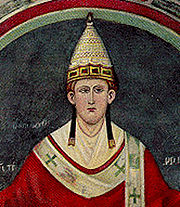
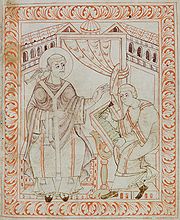
Vestment
Vestments are liturgical garments and articles associated primarily with the Christian religion, especially among Latin Rite and other Catholics, Eastern Orthodox, Anglicans, and Lutherans...
in the Roman Catholic Church
Roman Catholic Church
The Catholic Church, also known as the Roman Catholic Church, is the world's largest Christian church, with over a billion members. Led by the Pope, it defines its mission as spreading the gospel of Jesus Christ, administering the sacraments and exercising charity...
, originally peculiar to the Pope
Pope
The Pope is the Bishop of Rome, a position that makes him the leader of the worldwide Catholic Church . In the Catholic Church, the Pope is regarded as the successor of Saint Peter, the Apostle...
, but for many centuries bestowed by him on metropolitans
Metropolitan bishop
In Christian churches with episcopal polity, the rank of metropolitan bishop, or simply metropolitan, pertains to the diocesan bishop or archbishop of a metropolis; that is, the chief city of a historical Roman province, ecclesiastical province, or regional capital.Before the establishment of...
and primates
Primate (religion)
Primate is a title or rank bestowed on some bishops in certain Christian churches. Depending on the particular tradition, it can denote either jurisdictional authority or ceremonial precedence ....
as a symbol of the jurisdiction delegated to them by the Holy See
Holy See
The Holy See is the episcopal jurisdiction of the Catholic Church in Rome, in which its Bishop is commonly known as the Pope. It is the preeminent episcopal see of the Catholic Church, forming the central government of the Church. As such, diplomatically, and in other spheres the Holy See acts and...
. In that context it has always remained unambiguously connected to the papacy. Essentially the same garment is worn by all Eastern Orthodox bishops, and is called omophor.
Description
The pallium, in its present Western form, is a narrow band, "three fingers broad", woven of white lamb's wool from sheep raised by TrappistTRAPPIST
TRAPPIST is Belgian robotic telescope in Chile which came online in 2010, and is an acronym for TRAnsiting Planets and PlanetesImals Small Telescope, so named in homage to Trappist beer produced in the Belgian region. Situated high in the Chilean mountains at La Silla Observatory, it is actually...
monks, with a loop in the centre resting on the shoulders over the chasuble
Chasuble
The chasuble is the outermost liturgical vestment worn by clergy for the celebration of the Eucharist in Western-tradition Christian Churches that use full vestments, primarily in the Roman Catholic, Anglican and Lutheran churches, as well as in some parts of the United Methodist Church...
and two dependent lappets, before and behind; so that when seen from front or back the ornament resembles the letter Y. It is decorated with six black crosses, one on each tail and four on the loop, is doubled on the left shoulder and sometimes is garnished, back and front, with three jewelled gold pins. The two latter characteristics seem to be survivals of the time when the Roman pallium was a simple scarf doubled and pinned on the left shoulder.
In origin the pallium and the omophor are the same vestment. The omophor is a wide band of cloth, much larger than the modern pallium, worn by all Eastern Orthodox bishop
Bishop
A bishop is an ordained or consecrated member of the Christian clergy who is generally entrusted with a position of authority and oversight. Within the Catholic Church, Eastern Orthodox, Oriental Orthodox Churches, in the Assyrian Church of the East, in the Independent Catholic Churches, and in the...
s and Eastern Catholic bishops of the Byzantine Rite
Byzantine Rite
The Byzantine Rite, sometimes called the Rite of Constantinople or Constantinopolitan Rite is the liturgical rite used currently by all the Eastern Orthodox Churches, by the Greek Catholic Churches , and by the Protestant Ukrainian Lutheran Church...
. The theory that explains its origin in connection with the figure of the Good Shepherd
Good Shepherd
Good Shepherd may refer to:In Christianity:* The Good Shepherd , pericope found in John 10:1-21, and a popular image in which the Good Shepherd represents Jesus...
carrying the lamb on his shoulders, so common in early Christian art, may be an explanation a posteriori
A Posteriori
Apart from the album, some additional remixes were released exclusively through the iTunes Store. They are:*"Eppur si muove" – 6:39*"Dreaming of Andromeda" Apart from the album, some additional remixes were released exclusively through the iTunes Store. They are:*"Eppur si muove" (Tocadisco...
. The ceremonial connected with the preparation of the pallium and its bestowal upon the Pope at his coronation, however, suggests some such symbolism. The lambs whose wool is destined for the making of the pallia are solemnly presented at the altar by the nuns of the convent of Saint Agnes
Saint Agnes
Agnes of Rome is a virgin–martyr, venerated as a saint in the Roman Catholic Church, Eastern Orthodox Church, the Anglican Communion, and Lutheranism. She is one of seven women, excluding the Blessed Virgin, commemorated by name in the Canon of the Mass...
. The Benedictine nuns of Santa Cecilia in Trastevere
Santa Cecilia in Trastevere
Santa Cecilia in Trastevere is a 5th century church in Rome, Italy, devoted to Saint Cecilia, in the Trastevere rione.-History:The first church on this site was founded probably in the 3rd century, by Pope Urban I; it was devoted to the Roman martyr Cecilia, martyred it is said under Marcus...
later weave the lambs' wool into pallia.
The awarding of the pallium became controversial in the Middle Ages
Middle Ages
The Middle Ages is a periodization of European history from the 5th century to the 15th century. The Middle Ages follows the fall of the Western Roman Empire in 476 and precedes the Early Modern Era. It is the middle period of a three-period division of Western history: Classic, Medieval and Modern...
, because popes charged a fee from those receiving them, earning hundreds of millions of gold florins
Italian coin florin
The Italian florin was a coin struck from 1252 to 1533 with no significant change in its design or metal content standard. It had 54 grains of nominally pure gold worth approximately 200 modern US Dollars...
for the papacy and bringing the award of the pallium into disrepute. This process was condemned by the Council of Basel in 1432, which referred to it as "the most usurious contrivance ever invented by the papacy". The fee was later abandoned amid charges of simony
Simony
Simony is the act of paying for sacraments and consequently for holy offices or for positions in the hierarchy of a church, named after Simon Magus , who appears in the Acts of the Apostles 8:9-24...
.
For his formal inauguration Pope Benedict XVI
Pope Benedict XVI
Benedict XVI is the 265th and current Pope, by virtue of his office of Bishop of Rome, the Sovereign of the Vatican City State and the leader of the Catholic Church as well as the other 22 sui iuris Eastern Catholic Churches in full communion with the Holy See...
adopted an earlier form of the pallium, from a period when it and the omophor were virtually identical. It is wider than the modern pallium although not as wide as the modern omophor, made of wool with black silk ends, and decorated with five red crosses, three of which are pierced with pins, symbolic of Christ's five wounds and the three nails. Only the Papal pallium was to take this distinctive form. Beginning with the Solemnity of Saints Peter and Paul (June 29, 2008) Benedict XVI reverted to a form similar to that worn by his recent predecessors, albeit in a larger and longer cut and with red crosses, therefore remaining distinct from pallia worn by metropolitans.
At present only the Pope, metropolitan archbishops
Metropolitan bishop
In Christian churches with episcopal polity, the rank of metropolitan bishop, or simply metropolitan, pertains to the diocesan bishop or archbishop of a metropolis; that is, the chief city of a historical Roman province, ecclesiastical province, or regional capital.Before the establishment of...
, and the Latin Rite Patriarch of Jerusalem
Latin Patriarch of Jerusalem
The Latin Patriarch of Jerusalem is the title possessed by the Latin Rite Catholic Archbishop of Jerusalem. The Archdiocese of Jerusalem has jurisdiction for all Latin Rite Catholics in Israel, the Palestinian Territories, Jordan and Cyprus...
wear the pallium. Under the 1917 Code of Canon Law, a metropolitan had to receive the pallium before exercising his office in his ecclesiastical province
Ecclesiastical Province
An ecclesiastical province is a large jurisdiction of religious government, so named by analogy with a secular province, existing in certain hierarchical Christian churches, especially in the Catholic Church and Orthodox Churches and in the Anglican Communion...
, even if he was previously metropolitan elsewhere, but these restrictions were absent in the revised 1983 Code of Canon Law
1983 Code of Canon Law
The 1983 Code of Canon Law is the codification of canonical legislation for the Latin Rite of the Catholic Church...
. No other bishops, even non-metropolitan archbishops or retired metropolitans, are allowed to wear the pallium unless they have special permission. An explicit exception is made for the rarely-realised scenario in which a person not yet a bishop is appointed Pope, in which case the bishop ordaining the new Pope wears the pallium during the ceremony.
History
It is impossible to indicate exactly when the pallium was first introduced. According to the Liber PontificalisLiber Pontificalis
The Liber Pontificalis is a book of biographies of popes from Saint Peter until the 15th century. The original publication of the Liber Pontificalis stopped with Pope Adrian II or Pope Stephen V , but it was later supplemented in a different style until Pope Eugene IV and then Pope Pius II...
, it was first used in the first half of the fourth century, although Tertullian wrote an essay no later than 220 AD titled De Pallio (On the Pallium). This book relates, in the life of Pope Marcus (†336), that he conferred the right of wearing the pallium on the Bishop of Ostia
Bishop of Ostia
The Bishop of Ostia is the head of the Suburbicarian Diocese of Ostia, one of the seven suburbicarian sees of Rome. The position is now attached to the post of Dean of the College of Cardinals, as it has been since 1150, with the actual governance of the diocese entrusted to the Vicar General of...
, because the consecration
Consecration
Consecration is the solemn dedication to a special purpose or service, usually religious. The word "consecration" literally means "to associate with the sacred". Persons, places, or things can be consecrated, and the term is used in various ways by different groups...
of the pope appertained to him. At any rate, the wearing of the pallium was usual in the fifth century; this is indicated by the above-mentioned reference contained in the life of St Marcus which dates from the beginning of the sixth century, as well as by the conferring of the pallium on St. Cæsarius of Arles by Pope Symmachus
Pope Symmachus
Saint Symmachus was pope from 498 to 514. His tenure was marked by a serious schism over who was legitimately elected pope by the citizens of Rome....
in 513. Besides, in numerous other references of the sixth century, the pallium is mentioned as a long-customary vestment. It seems that, from the beginning, the pope alone had the absolute right of wearing the pallium. Its use by others was tolerated only by virtue of the permission of the pope. We hear of the pallium being conferred on others, as a mark of distinction, as early as the sixth century. The honour was usually conferred on metropolitans, especially those nominated vicar
Vicar
In the broadest sense, a vicar is a representative, deputy or substitute; anyone acting "in the person of" or agent for a superior . In this sense, the title is comparable to lieutenant...
s by the pope, but it was sometimes conferred on simple bishops (e.g., on Syagrius of Autun, Donus of Messina, and John of Syracuse by Pope Gregory I
Pope Gregory I
Pope Gregory I , better known in English as Gregory the Great, was pope from 3 September 590 until his death...
).
The use of the pallium among metropolitans did not become general until the ninth century, when the obligation was laid upon all Western metropolitans of forwarding a petition for the pallium accompanied by a solemn profession of faith, all consecrations being forbidden them before the reception of the pallium. The oath of allegiance
Oath of allegiance
An oath of allegiance is an oath whereby a subject or citizen acknowledges a duty of allegiance and swears loyalty to monarch or country. In republics, modern oaths specify allegiance to the country's constitution. For example, officials in the United States, a republic, take an oath of office that...
which the recipient of the pallium takes today originated, apparently, in the eleventh century. It is met with during the reign of Paschal II (1099–118), and replaced the profession of faith. It is certain that a tribute
Tribute
A tribute is wealth, often in kind, that one party gives to another as a sign of respect or, as was often the case in historical contexts, of submission or allegiance. Various ancient states, which could be called suzerains, exacted tribute from areas they had conquered or threatened to conquer...
was paid for the reception of the pallium as early as the sixth century. This was abrogated by Pope Gregory I in the Roman Synod of 595, but was reintroduced later as partial maintenance of the Holy See. These pallium contributions have often been, since the Middle Ages
Middle Ages
The Middle Ages is a periodization of European history from the 5th century to the 15th century. The Middle Ages follows the fall of the Western Roman Empire in 476 and precedes the Early Modern Era. It is the middle period of a three-period division of Western history: Classic, Medieval and Modern...
, the subject of embittered controversies.
Origin
There are many different opinions concerning the origin of the pallium. Some trace it to an investitureDonation of Constantine
The Donation of Constantine is a forged Roman imperial decree by which the emperor Constantine I supposedly transferred authority over Rome and the western part of the Roman Empire to the pope. During the Middle Ages, the document was often cited in support of the Roman Church's claims to...
by Constantine I
Constantine I
Constantine the Great , also known as Constantine I or Saint Constantine, was Roman Emperor from 306 to 337. Well known for being the first Roman emperor to convert to Christianity, Constantine and co-Emperor Licinius issued the Edict of Milan in 313, which proclaimed religious tolerance of all...
(or one of his successors); others consider it an imitation of the Hebrew ephod
Ephod
An ephod was an article of clothing, and a worship object, in ancient Israelite culture, and was closely connected with oracular practices....
, the humeral garment of the High Priest
Kohen Gadol
The High Priest was the chief religious official of Israelite religion and of classical Judaism from the rise of the Israelite nation until the destruction of the Second Temple of Jerusalem...
. Others again declare that its origin is traceable to a mantle of St. Peter, which was symbolical of his office as supreme pastor. A fourth hypothesis finds its origin in a liturgical mantle
Robe
A robe is a loose-fitting outer garment. A robe is distinguished from a cape or cloak by the fact that it usually has sleeves. The English word robe derives from Middle English robe , borrowed from Old French robe , itself taken from the Frankish word *rouba , and is related to the word rob...
, which, it is asserted, was used by the early popes, and which in the course of time was folded into the shape of a band; a fifth says its origin dates from the custom of folding the ordinary mantle-pallium, an outer garment in use in imperial times; a sixth declares that it was introduced immediately as a papal liturgical garment, which, however, was not at first a narrow strip of cloth, but, as the name suggests, a broad, oblong, and folded cloth. To trace it to an investiture of the emperor, to the ephod of the Jewish High Priest, or to a fabled mantle of St. Peter, is not supported. It may well be that the pallium was introduced as a liturgical badge of the pope, or that it was adopted in imitation of its counterpart, the pontifical omophor, already in vogue in the Eastern Church. Initially, it was bestowed on papal vicars (like the bishop of Arles, who represented the pope in the regions of Gaul) and other bishops with exclusive links to the Apostolic See
Apostolic See
In Christianity, an apostolic see is any episcopal see whose foundation is attributed to one or more of the apostles of Jesus.Out of the many such sees, five acquired special importance in Chalcedonian Christianity and became classified as the Pentarchy in Eastern Orthodox Christianity...
. Also in this rank were missionaries sent with papal approval to organise the church among newly converted people. St Augustine of Canterbury
Augustine of Canterbury
Augustine of Canterbury was a Benedictine monk who became the first Archbishop of Canterbury in the year 597...
in seventh-century England and St. Boniface in eighth-century Germany fell into this category.
Development
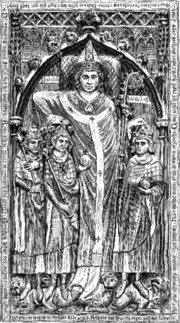
Ravenna
Ravenna is the capital city of the Province of Ravenna in the Emilia-Romagna region of Italy and the second largest comune in Italy by land area, although, at , it is little more than half the size of the largest comune, Rome...
mosaics. The pallium of the sixth century was a long, moderately wide, white band of wool, ornamented at its extremity with a black or red cross, and finished off with tassels; it was draped around the neck, shoulders, and breast in such a manner that it formed a V in front, and the ends hung down from the left shoulder, one in front and one behind.
In the eighth century it became customary to let the ends fall down, one in the middle of the breast and the other in the middle of the back, and to fasten them there with pins, the pallium thus becoming Y-shaped. A further development took place during the ninth century (according to pictorial representations, at first outside of Rome where ancient traditions were not maintained so strictly): the band, which had hitherto been kept in place by the pins, was sewn Y-shaped, without, however, being cut.
The present circular form originated in the tenth or eleventh century. Two excellent early examples of this form, belonging respectively to Archbishop St. Heribert
Heribert of Cologne
Saint Heribert was Archbishop of Cologne and Chancellor of Emperor Otto III, and was canonized c. 1074.-Life:He was born in Worms, the son of Hugo, count of Worms. He was educated in the school of Worms Cathedral and at the Benedictine Gorze Abbey in Lorraine...
(1021) and Archbishop St. Anno
Anno II, Archbishop of Cologne
Saint Anno II was Archbishop of Cologne from 1056 to 1075.He was born around 1010, belonging to the Swabian family of the von Steusslingen, and was educated at Bamberg. He became confessor to the Emperor Henry III, who appointed him archbishop of Cologne in 1056...
(d. 1075), are preserved in Siegburg
Siegburg
--122.148.78.228 05:06, 14 November 2011 Siegburg is a city in the district of Rhein-Sieg-Kreis, in North Rhine-Westphalia, Germany...
, Archdiocese of Cologne. The two vertical bands of the circular pallium were very long until the fifteenth century, but were later repeatedly shortened until they now have a length of only about twelve inches. At first the only decorations on the pallium were two crosses near the extremities. This is proved by the mosaics at Ravenna and Rome. It appears that the ornamentation of the pallium with a greater number of crosses did not become customary until the ninth century, when small crosses were sewn on the pallium, especially over the shoulders. There was, however, during the Middle Ages no definite rule regulating the number of crosses, nor was there any precept determining their colour. They were generally dark, but sometimes red. The pins, which at first served to keep the pallium in place, were retained as ornaments even after the pallium was sewn in the proper shape, although they no longer had any practical object. That the insertion of small leaden weights in the vertical ends of the pallium was usual as early as the thirteenth century is proved by the discovery in 1605 of the pallium enveloping the body of Boniface VIII, and by the fragments of the pallium found in the tomb of Clement IV.
Modern use

Feast of Saints Peter and Paul
The Feast of Saints Peter and Paul, or the Solemnity of Saints Peter and Paul, is a liturgical feast in honour of the martyrdom in Rome of the apostles Saint Peter and Saint Paul, which is observed on 29 June...
in June. The pallium is also conferred upon the Latin Rite Patriarch of Jerusalem
Latin Patriarch of Jerusalem
The Latin Patriarch of Jerusalem is the title possessed by the Latin Rite Catholic Archbishop of Jerusalem. The Archdiocese of Jerusalem has jurisdiction for all Latin Rite Catholics in Israel, the Palestinian Territories, Jordan and Cyprus...
. Previous traditions that allowed some other bishops to use the pallium were ended by Pope Paul VI in a motu proprio
Motu proprio
A motu proprio is a document issued by the Pope on his own initiative and personally signed by him....
in 1978. A metropolitan archbishop may wear his pallium as a mark of his jurisdiction not only in his own archdiocese but anywhere in his ecclesiastical province whenever he celebrates Mass (Canon 437, Code of Canon Law, 1983).
Although the pallium is now reserved, by law and liturgical norms, to metropolitans, a single standing exception has seemed to become customary: Pope John Paul II conferred a pallium on then-Cardinal Joseph Ratzinger when Ratzinger became dean of the College of Cardinals and therefore also Cardinal Bishop of Ostia
Bishop of Ostia
The Bishop of Ostia is the head of the Suburbicarian Diocese of Ostia, one of the seven suburbicarian sees of Rome. The position is now attached to the post of Dean of the College of Cardinals, as it has been since 1150, with the actual governance of the diocese entrusted to the Vicar General of...
, a purely honorary title and one without an archbishopric or metropolitanate attached. When Ratzinger was elected Pope Benedict XVI, he continued that exception without comment by conferring the pallium on Cardinal Angelo Sodano, the new dean.
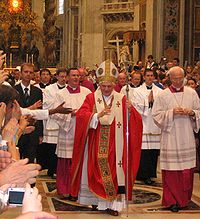
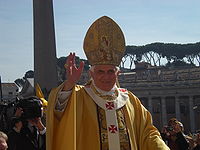
Second Vatican Council
The Second Vatican Council addressed relations between the Roman Catholic Church and the modern world. It was the twenty-first Ecumenical Council of the Catholic Church and the second to be held at St. Peter's Basilica in the Vatican. It opened under Pope John XXIII on 11 October 1962 and closed...
(1962–65), the liturgy for the conferral of the pallium as it appears in the liturgical book
Liturgical book
A liturgical book is a book published by the authority of a church, that contains the text and directions for the liturgy of its official religious services.-Roman Catholic:...
s is to take place at the beginning of the Mass in which the archbishop takes possession of his see; however, the practice of Pope John Paul II and Pope Benedict XVI has actually been to summon all new metropolitans to Rome to receive the pallium directly from the hands of the pope on the Feast of Saints Peter and Paul.
Significance
As early as the 6th century the pallium was considered a liturgical vestment to be used only in the church, and indeed only during Mass, unless a special privilege determined otherwise. This is proved conclusively by the correspondence between Pope Gregory IPope Gregory I
Pope Gregory I , better known in English as Gregory the Great, was pope from 3 September 590 until his death...
and John of Ravenna concerning the use of the pallium. The rules regulating the original use of the pallium cannot be determined with certainty, but its use, even before the 6th century, seems to have had a definite liturgical character. From early times more or less extensive restrictions limited the use of the pallium to certain days. Its indiscriminate use, permitted to Hincmar of Reims by Leo IV
Pope Leo IV
Pope Saint Leo IV was pope from 10 April 847 to 17 July 855.A Roman by birth, he was unanimously chosen to succeed Sergius II. When he was elected, on 10 April 847, he was cardinal of Santi Quattro Coronati, and had been subdeacon of Gregory IV and archpriest under his predecessor...
(851) and to Bruno of Cologne
Bruno of Cologne
Saint Bruno of Cologne , the founder of the Carthusian Order, personally founded the order's first two communities...
by Agapetus II (954) was contrary to the general custom. In the 10th and 11th centuries, just as today, the general rule was to limit the use of the pallium to a few festivals and some other extraordinary occasions. The symbolic character now attached to the pallium dates back to the 9th century, when it was made an obligation for all metropolitans to petition the Holy See for permission to use it. The evolution of this character was complete about the end of the eleventh century; thenceforth the pallium is always designated in the papal bulls as the symbol of plenitudo pontificalis officii. In the sixth century the pallium was the symbol of the papal office and the papal power, and for this reason Pope Felix transmitted his pallium to his archdeacon, when, contrary to custom, he nominated him his successor. On the other hand, when used by metropolitans, the pallium originally signified simply union with the Apostolic See, and was an ornament symbolizing the virtue and rank of its wearer.

